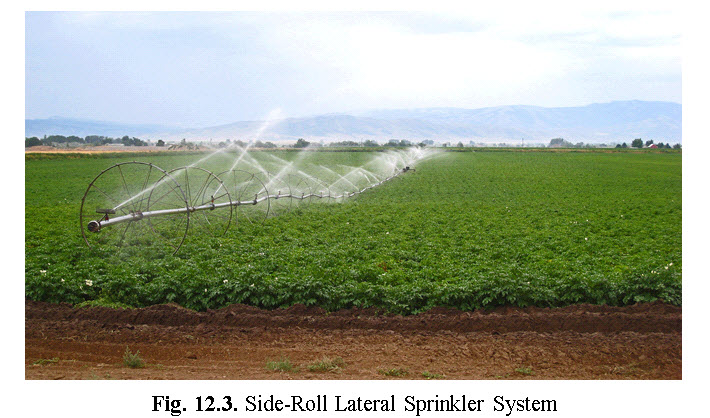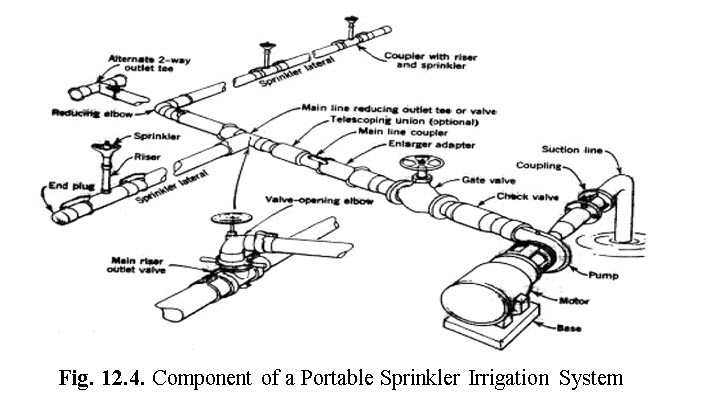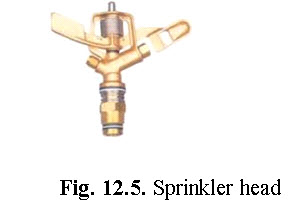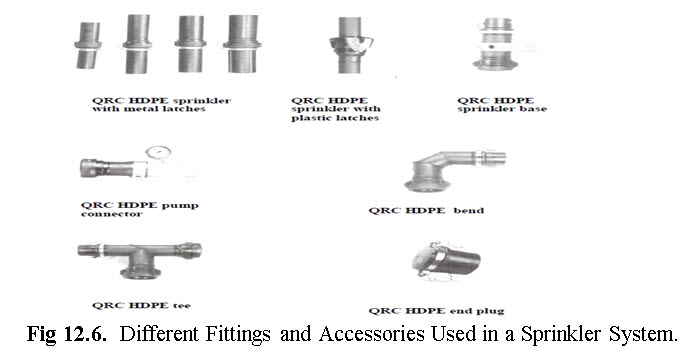Site pages
Current course
Participants
General
Module 1. Micro-irrigation
Module 2. Drip Irrigation System Design and Instal...
Module 3. Sprinkler Irrigation
Module 4. Fertigation System
Module 5. Quality Assurance & Economic Analysis
Module 6. Automation of Micro Irrigation System
Module 7. Greenhouse/Polyhouse Technology
Lesson 12. Classification and Components of Sprinkler Systems
Sprinklers, laterals, submains, and mainlines are the primary components of a sprinkler irrigation system. Sprinklers spread water as “rain droplets” over the land surface. Laterals get water from the mainlines and submains convey to the sprinklers. Mainlines convey water from the water source to the submains and laterals. Types and components of sprinkler systems are discussed in this lesson.
12.1 Types of Sprinkler Irrigation Systems
Sprinkler irrigation systems may be classified as portable, semi-portable, semi-permanent, or permanent. On the basis water application the sprinkler systems are classified into the following two major types:
1. Rotating head or revolving sprinkler system.
2. Perforated pipe system.
1) Rotating head
Small size nozzles are placed on riser pipes fixed at uniform intervals along the length of the lateral pipe and the lateral pipes are usually laid on the ground surface. They may also be mounted on posts above the crop height and rotated through 90o, to irrigate a rectangular strip. In rotating type sprinklers, the most common device to rotate the sprinkler heads is with a small hammer activated by the thrust of water striking against a vane connected to it. Fig. 12.1. shows the different types of rotating head sprinkler irrigation systems.

Fig.12.1. Rotating Head Sprinkler Irrigation System
(Source: www.agritech.tnau.ac.in)
2) Perforated pipe system
This method consists of drilled holes or nozzles along their length through which water is sprayed under pressure. This system is usually designed for relatively low pressure (1 kg/cm2). The application rate ranges from 1.25 mm to 50 mmh-1 for various pressures and spacing.
Based on the portability, sprinkler systems are classified into the following types:
(i) Portable system: A portable system has portable mainlines, sub-mains, laterals, and a portable pumping plant. The entire system can be moved from field to field. Fig. 12.2. shows the fully portable sprinkler irrigation system.

(Source: www.agritech.tnau.ac.in)
ii) Semi-portable system
A semi-portable system is similar to a fully portable system except that the location of water source and pumping plant is fixed. Such a system may be used on more than one field where there is an extended mainline, but may not be used on more than one farm unless there are additional pumping plants.
iii) Semi-permanent system
A semi-permanent system has portable lateral lines, permanent mainlines, and a stationary water source and pumping plant. The mainline are usually buried, risers are (located at suitable intervals) to connect with laterals.
iv) Permanent system
A fully permanent system has buried mainlines, sub-mains, and laterals with a stationary pumping plant and/or water source. Sprinklers are permanently located on each riser. Such systems are costly and are suited to automation.
v) Solid set system
A solid set system has enough laterals to eliminate their movement. The laterals are installed in the field early in the crop season and remain for the season.
vi) Set-move irrigation systems
Set-move sprinkle systems are moved from one set (irrigation) position to another by hand or mechanically. Set-move systems remain stationary when water is applied. When the desired amount of water has been applied, the water is shut off and the sprinkler laterals are drained and moved to the next set position. When the move is complete the water is turned on and irrigation resumed at the new set position. This sequence is repeated until the entire field has been irrigated. Set-move systems commonly have a single mainline laid through the centre of the field with one or more laterals on each side of the mainline.
a) Hand-move
In hand-move system laterals are moved by uncoupling, picking –up, and carrying sections of lateral pipe by hand to the next set position where the lateral sections are reconnected. Earlier hand-move sprinkler laterals were made up of aluminium now these are replaced with HDPE of 50 to 150 mm(2 to 6 in) in diameter, and 6, 9, or 12 m (20, 30, or 40 ft) long are difficult to handle and may not provide proper spacing for the common sprinkler sizes.
b) Tow-move
Tow-move sprinkler systems are the least expensive type of mechanically moved set-move system. Each section of a tow-move lateral has skids or wheels so that the entire laterals can be pulled to the next set position. Usually a tractor is hooked to the mainline end of the lateral and the lateral is dragged in the other direction across the mainline in an opposite S-shaped curve. The moves are made easier by buried mainlines.
Tow-move system are not used extensively because shifting of lateral is tedious, it requires careful attention, and also damages crops. Tow-move systems are suitable to forage and row crops.
c) Side-roll
A side-roll or wheel-move system, like the one is an extremely popular type of mechanically moved set-move system. Each section of pipe in a side-roll lateral has a wheel, with the pipe serving as the axle of the wheel. A gasoline engine and transmission with a reverse gear at the centre or the end of the lateral supplies the power needed to roll the lateral, which may be as long as 800 m (about one-half mile), from one set position to the next. The lateral is commonly 100 or 125 mm (4 or 5 in) in diameter. Each lateral section is usually 12.2 m (40 ft) long with a wheel at its centre and a sprinkler mounted on a short riser at one end. Often the sprinklers have self –levellers to “right” the sprinkler when the lateral is stopped so that the riser is tilted” from its upright position. A drain valve that opens automatically when there is a loss of pressure is usually located opposite each rise. This allows the lateral to be quickly drained and permits moving of lateral with a minimum time loss. The most common spacing along the mainline is 18.3 m (60 ft). The Fig. 12.3 shows a side-roll lateral sprinkler system used on a potato field.

(Source:http://here4now.typepad.com/.a/6a00d8341d171f53ef00e553baa49e8833i)
d) Gun-type
The set-move system consists of a larger-volume (big-gun) sprinkler mounted on a wheeled cart or trailer that is moved from set to set with a tractor or by hand. Sprinklers with capacities as large as 4700 L min-1(about 1250 gpm), wetted diameters of as much as 180 m (about 600 ft), and a recommended operating pressure range of 480 to 896 kPa (70 to 130 psi) are commonly used. These systems are sometimes used for waste water disposal.
12.2 Components of a Sprinkler System
Sprinklers, laterals, sub-mains, and mainlines are the primary components of a sprinkler irrigation system. Sprinklers spread water as “rainlike” droplets over the land surface. Laterals convey water from the mainline and sub-main to the sprinklers. Mainlines convey water from the water source to the sub-mains and laterals. Fig.12.4. shows the component of a portable sprinkler irrigation system. A sprinkler system usually consists of the following components.
i) A pump unit
ii) Tubing’s- main/sub-mains and laterals
iii) Couplers
iv) Sprinkler head
v) Other accessories such as valves, bends, plugs and risers.
i) Pumping unit
Sprinkler irrigation systems distribute water by spraying it over the fields. The water from the source (ground water / surface water) is pumped under pressure to sprinkler system. The pressure created through pump forces the water through sprinklers or through perforations or nozzles in pipelines and then forms a spray. A high speed centrifugal or turbine pump can be used for operating sprinkler irrigation for individual fields. Centrifugal pump is used when the distance from the pump inlet to the water surface is less than eight meters. For pumping water from deep wells or more than eight meters, a turbine submersible pump is used. The driving unit may be either an electric motor or an internal combustion engine.

(Source: Schwab etal.1993 pp. 427)
ii) Tubings
The tubing consists of mainline, sub-mains and laterals. Main line conveys water from the source and distributes it to the sub-mains. The sub-mains convey water to the laterals which in turn supply water to the sprinklers. Aluminium or PVC or HDPE pipes are generally used for portable systems, while steel pipes are usually used for centre-pivot laterals. Asbestos, cement, PVC and wrapped steel are usually used for buried laterals and main lines.
iii) Couplers
Couplers are used for connecting two pipes and uncoupling quickly and easily. Essentially a coupler should provide
a) a reuse and flexible connection
b) not leak at the joint
c) be simple and easy to couple and uncouple, and
d) be light, non-corrosive, and durable.
iv) Sprinkler head
Sprinkler head distribute water uniformly over the field without runoff or excessive loss due to deep percolation. Different types of sprinklers are available. They are either rotating or fixed type. The rotating type can be adapted for a wide range of application rates and spacing. They are effective with pressure of about 10 to 70 m head at the sprinkler. Pressures ranging from 16 to 40 m head are considered the most practical for most farmers.
Fixed head sprinklers are commonly used to irrigate small lawns and gardens. Perforated lateral lines are sometimes used as sprinklers. They require less pressure than rotating sprinklers. They release more water per unit area than rotating sprinklers. Hence fixed head sprinklers are adaptable for soils with high intake rate. Fig. 12.5. shows the rotating head sprinkler head.

(Source:www.jains.com/irrigation/popups%20and%20sprinklers/sprinklersystems htm).
v) Fittings and accessories: Fig 12.5 shows different types of sprinkler fittings and accessories. The following are some of the important fittings and accessories used in sprinkler system.
a) Water meters: It is used to measure the volume of water delivered. This is necessary to operate the system to supply the required quantity of water.
b) Flange, couplings and nipples are used for proper connection to the pump, suction and delivery.
c) Pressure gauge: It is used to measure operating pressure of sprinkler system. to ensure application uniformity, the sprinkler system is operated at desired pressure.
d) Bend, tees, reducers, elbows, hydrants, butterfly valve and plugs are optimal components of a sprinkler system. They are used as per requirements.

(Source: www.agritech.tnau.ac.in)
e) Fertilizer applicator: Soluble chemical fertilizers can be injected into the sprinkler system and applied to the crop. The fertilizer applicator consists of a sealed fertilizer tank with necessary tubings and connections. A venturi injector is connected with the main line, which creates the differential pressure suction and allows the fertilizer solution to flow in the main water line.
References:
www.agritech.tnau.ac.in
http://here4now.typepad.com/.a/6a00d8341d171f53ef00e553baa49e8833-pi
G.O.S,D.D.F & W.J.E.,(1993). Soil and Water Conservation Engineering. Hamilton Printing Company.pp. 427.
Schwab, G. O., Fangmeier, D. D., Elliot, W. J., and Frevert, R. K. (1993). Soil and Water Conservation Engineering. John Willey & Sons, Inc., New York, NY USA. pp.424.
Suggested Reading:
Heermann, D.F. and Kohl, R.A. (1980). Fluid Dynamics of of sprinkler Systems. (Chapter 14 in Design and operation of Farm irrigation systems. Edited by Jenson, M.E.) ASAE Monograph 3. St. Joseph, MI.
Michael, A. M., (2010). Irrigation Theory and Practice, Vikas Publishing House Pvt. Ltd, Delhi, India, pp.603.
James Larry G. (1988). Principles of Farm Irrigation System Design. John Wiley & Sons. New York pp.69.